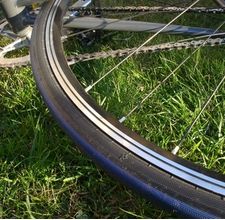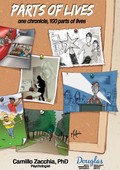Do you every see someone with an obvious physical defect and feel like Austin Powers trying not to point out the mole on the “mole’s” face? Or how about not looking at the cleavage of a well-endowed woman?
Normally we are in ‘control’ of what we do but we occasionally confront a situation where it would be embarrassing (or even dangerous) to lose control of ourselves and do something we shouldn’t. More often than not, these thoughts are benign (staring at a mole or peeking at cleavage) but occasionally they can be quite disturbing.
Anxiety’s role is to protect us and to make us mindful of dangers or ‘bad things’. The main dangers for us humans include dying, losing our minds, or making a fool of ourselves. As a result, anxiety makes us imagine them. It’s a way of reminding us to be careful. These ‘bad things’ often get translated into either a general uneasy feeling while in certain circumstances or into more specific thoughts or images.
There is no limit to the dangers anxiety can conjure up and they tend to fall into the three categories of fears mentioned above. Here are a few of the more common ones that people consult for. (I will not edit out the most disturbing ones. The point is these are VERY common.) :
Fear of dying: Car crashes, terrorist attacks, fires, ‘catching’ AIDS, planes crashing on you from above… etc.
Fear of losing your mind: Molesting a child, killing your family, slashing your throat, driving into oncoming traffic, running over a pedestrian, becoming gay (against your natural attraction), running off a rooftop or metro platform, strangling your baby…etc.
Fear of making a fool of yourself: Staring at a person’s physical defect, saying something stupid, having your zipper open or a booger on your face…etc.
People are most disturbed when the horrible events are imagined to be caused by themselves (in other words, as a resulting of losing control). The more we try to control our thoughts, the more we focus on them. All we manage to do is give them more weight and make them come more often. The reality is that these are manifestations of FEAR not of DESIRE. The more we fear something the more we imagine it. Imagining something horrible only makes us more careful, not more dangerous.
In today’s Métro column, I discuss a form of OCD where people are plagued by horrific thoughts. (See also my post on the topic from 2010: I get bad thoughts). My point is a simple one: Anxiety is a FEAR of something, not the thing itself. Scary thoughts are normal. If something is not dangerous, it doesn’t matter if you have no control over it. Actions need to be controlled. Thoughts do not.

Bicycle crash
(source: Accidents de Vélo. Journal Métro, November 19, 2013) . Voir plus bas pour la version Française.I spend many hours per week riding my bicycle and when I do so I am generally quite relaxed. Yet somehow I am often awaken in the middle of the night with stark and disturbing images of bike crashes. I imagine all sorts of horrible accidents involving cars, trees, animals, boulders, you name it. Is there something wrong with me?
Needless to say, I don’t enjoy these images, yet in one sense I am very happy to have them. This is because I understand that it is just my anxiety speaking to me and reminding me to be careful.
Many people struggle with unwanted or disturbing thoughts. In fact, there is a form of obsessive-compulsive disorder where individuals are disturbed by horrific thoughts involving accidents or even deliberate actions such as harming your own baby, driving into oncoming traffic or jumping in front of a metro. There is no shortage of extremely disturbing images the mind can conjure up.
It isn’t fun to think about these things but whether we like to admit it or not, we all get them. There has been plenty of research showing that so-called ‘normal’ people get the same thoughts and images as ‘obsessive’ individuals get. The only difference is in how they are seen.
Most people just blow them off. They see them as signs of fear combined with an overactive imagination. To the obsessive individual, however, they take on a much greater meaning. Just like a hypochondriac to whom a headache is not merely a headache but a possible sign of cancer, obsessive people will see these images as possible signs of insanity. To them an image means they may lose their minds and do the things they are most terrified of.
I probably have as many disturbing thoughts as anyone else. Of course I hate getting them, but like pain, anxiety is not designed to be pleasant, it is designed to be functional. Anxiety’s purpose is to keep us alive and attentive to dangers. When it says, “Be careful,” anxiety can do so with some pretty vivid images.
This is why I don’t question my disturbing bicycle crash images. I accept them because I see them as a sign my mind is working normally. People who see them as signs of insanity or of secret evil desires try to stop them. I can assure you they will fail miserably. All they will succeed in doing is feeding their anxiety. They will then have a real problem to deal with: anxiety itself.
_________________________________________________________________
Voici la version Française:
Je passe plusieurs heures par semaine à faire du vélo, et ça me détend beaucoup. Pourtant, je me fais souvent réveiller au milieu de la nuit par des images troublantes d’accidents de vélo. J’imagine toutes sortes d’accidents horribles mettant en cause des voitures, des arbres, des animaux, des rochers, etc. Y a-t-il quelque chose qui ne va pas chez moi?
Bien sûr, ces images ne me plaisent pas, mais en un sens, je ne suis pas mécontent de les avoir : c’est mon anxiété qui prend la parole pour me rappeler d’être prudent.
Bien des gens sont aux prises avec des pensées non désirées ou inquiétantes. En fait, il existe une forme de trouble obsessionnel-compulsif où les personnes sont perturbées par des pensées horrifiques d’accidents, ou même de gestes délibérés, comme blesser son enfant, conduire en sens inverse de la circulation ou sauter devant une rame de métro. Il ne manque pas d’images très troublantes que l’esprit peut faire apparaître.
Il n’est pas agréable de penser à ces choses, mais, que nous l’admettions ou non, cela nous arrive à tous. De nombreuses recherches ont démontré que les personnes soi-disant « normales » ont les mêmes pensées et images que les personnes dites « obsessionnelles ». La seule différence est la façon de les considérer.
La plupart des gens se contentent de les repousser du revers de la main. Ils les voient comme des signes de peur, alliés à une imagination hyperactive. Mais, pour une personne obsessionnelle, ces images revêtent une signification beaucoup plus importante. Tout comme l’hypocondriaque pour qui un simple mal de tête peut être un signe possible de cancer, les personnes obsessionnelles verront ces images comme des signes possibles de folie. Pour elles, une image signifie qu’elles peuvent perdre l’esprit et faire les choses qu’elles craignent le plus.
J’ai probablement autant de pensées troublantes que n’importe qui d’autre. Bien sûr, je n’aime pas les avoir; mais comme la douleur, l’anxiété n’est pas destinée à être plaisante, mais fonctionnelle. Le but de l’anxiété est de nous garder en vie et attentifs aux dangers. Pour nous dire d’être prudents, l’anxiété peut recourir à des images très frappantes.
C’est pourquoi je ne remets pas en question mes images troublantes d’accidents de vélo. Je les vois comme un signe du bon fonctionnement de mon esprit. Les gens qui les voient comme des signes de folie ou d’un désir malsain tentent d’y mettre fin. Je peux vous assurer qu’ils échoueront lamentablement. Tout ce qu’ils arriveront à faire, c’est de nourrir leur anxiété. Ils auront alors un vrai problème à traiter : l’anxiété elle-même.
Tagged as fear of losing control, horrific thoughts, Obsessive-Compulsive disorder, OCD, TOC.
Posted in Anxiety.
Posted on 19 Nov 2013
